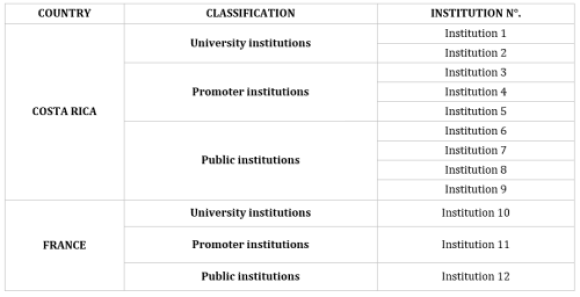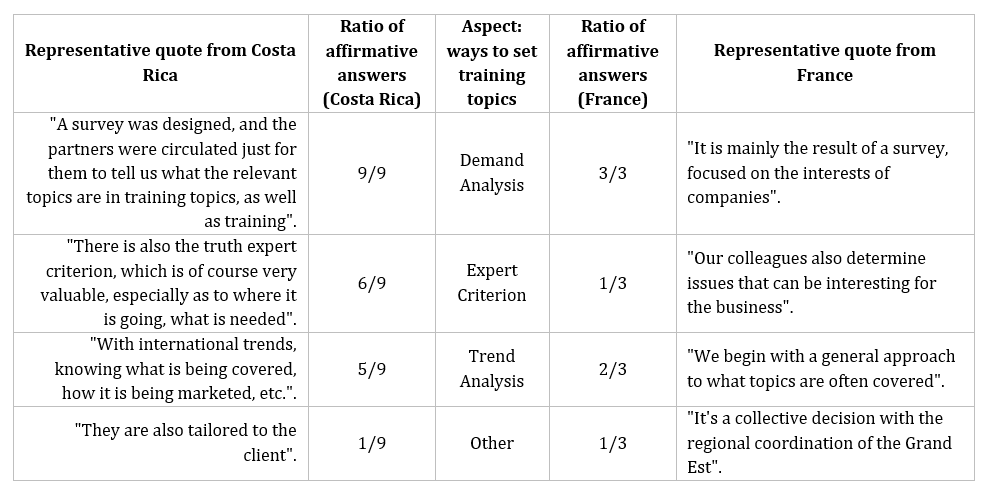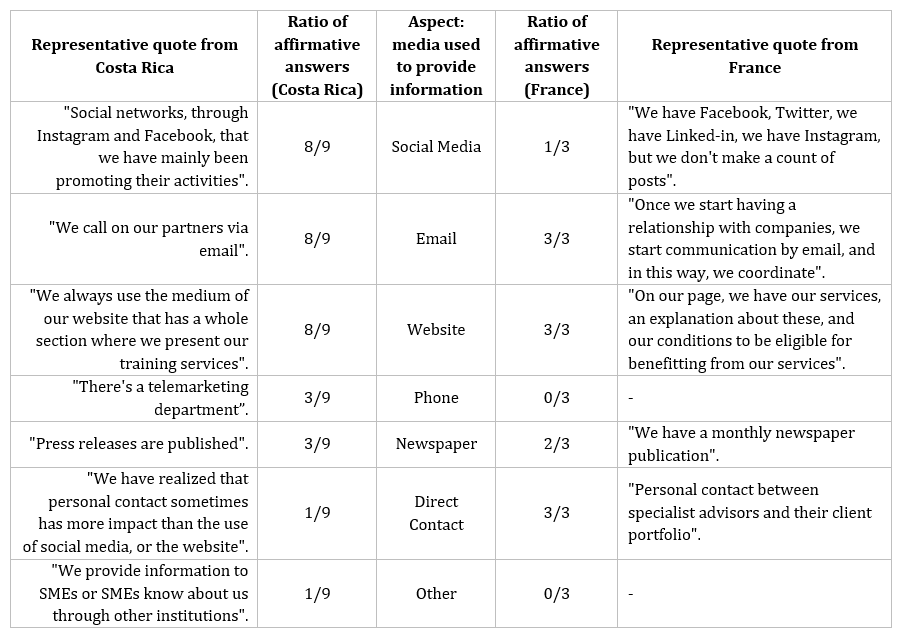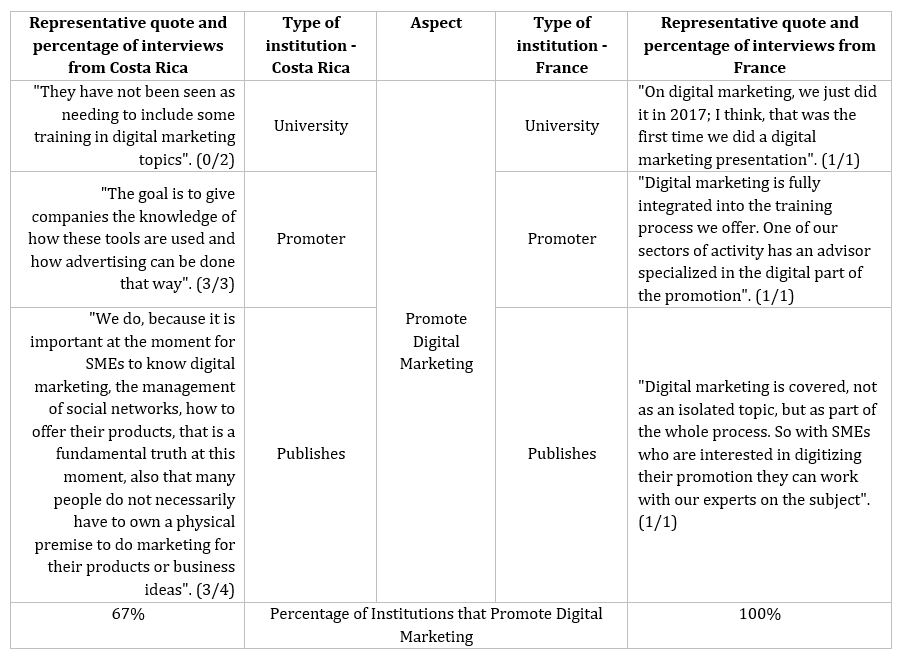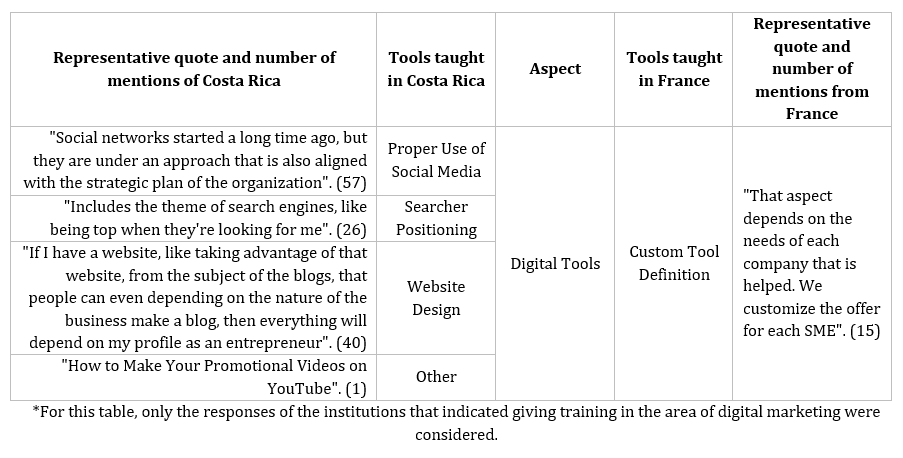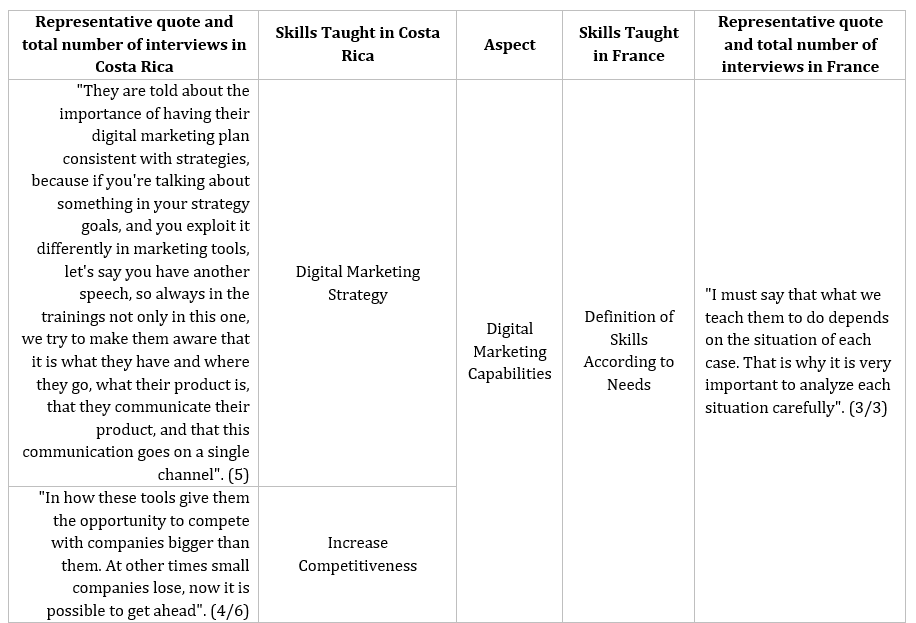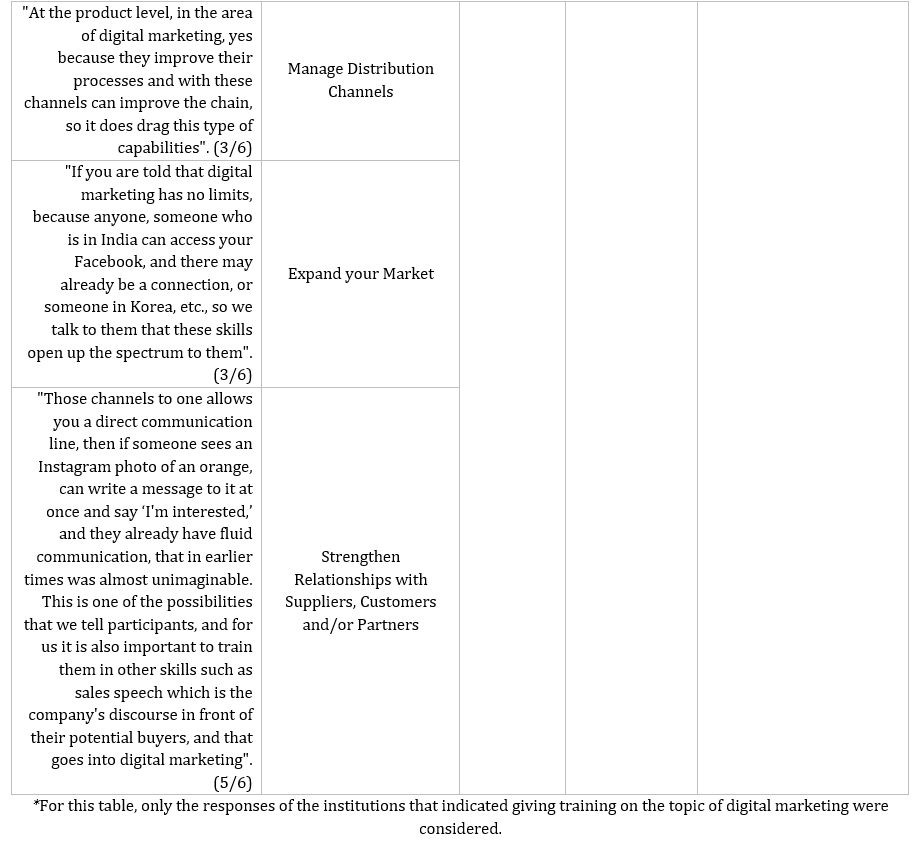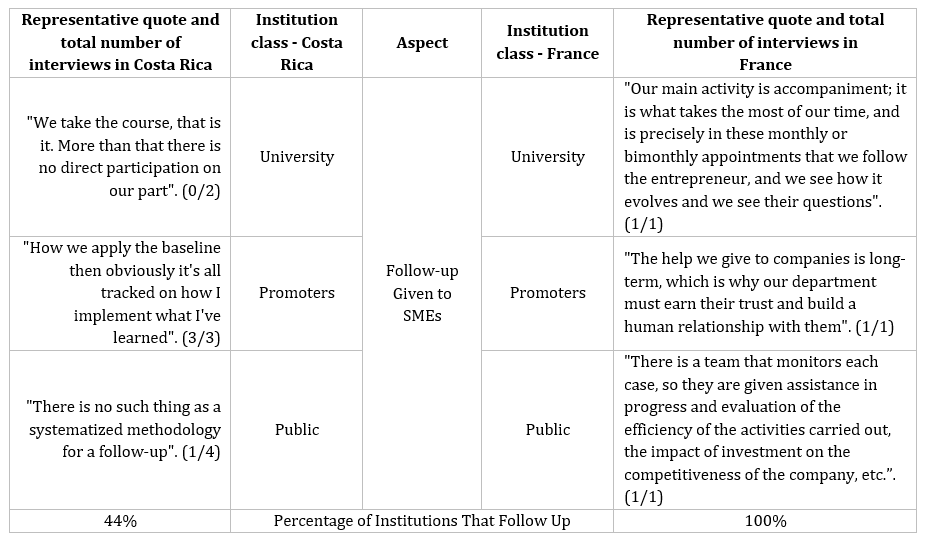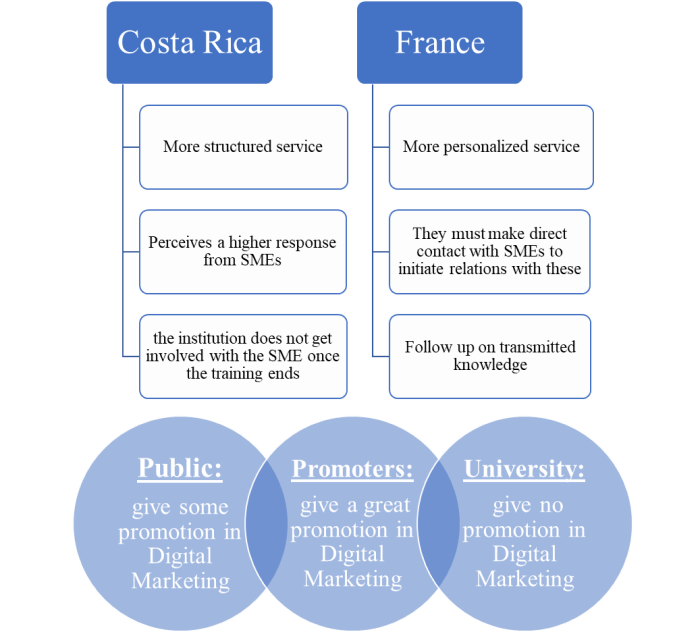AbstractMarketers need to build digital relationships and reputation before closing a sale.
Chris Brogan
Chief Executive Officer of Owner Media Group
The objective of this paper is to analyze institutional promotions to small and medium international enterprises on the subject of digital marketing. The authors conduct qualitative research with a descriptive scope, including 12 institutions in Costa Rica and France. The study is dedicated to working with SMEs involved in an internationalization process and offering them some type of training. for the collection of information, an in-depth interview with each participant was applied. It concludes that SMEs promote digital marketing through institutions, and that the way in which they carry it out varies between the two countries, Costa Rica being a more general and structured service, and France a more customized one.
Introduction
More and more companies want to embrace the digital world in order to gain visibility in their existing market, as well as enter into new ones. Nowadays, even companies that are still small already have an internet presence, some starting from an early stage.
Pérez-Fabara and Charro (2017) state that: “The use and availability of technological resources has emerged as a cultural complement for men. It has allowed the latest evolutions in the electronic field leading to an easy accessibility to digital consumers. As a consequence, the human being has been transformed into an element of change that faces the current paradigms within the environments in which he evolves”.
Thus, consumer behavior is very different from what it was not so many years ago, partly because we have entered a digital age in which companies must adapt in order to remain competitive. Part of this adaptations is the emergence of digital marketing, which has become an essential tool to promote products and services, and also to relate to a company’s current and potential customers (Cangas Muxica & Guzmán Pinto, 2010; Alford & Page, 2015).
Digital marketing also appears as an interesting lever in the current context of globalization. Indeed, international activities have been identified as one of the most important levers for economic growth (Bołkunow 2019). While traditionally, international competition has been restricted to large companies, the context has radically changed, and small and medium-sized enterprises (SMEs) are now pushed to internationalize in order to survive (Lemaire, 2013). To help with this, digital marketing can become a useful tool for small businesses that want to expand their horizons into new international markets (Morgan et al. , 2012). However, despite being an accessible option for this type of business, the best way to use it is open to consideration (Lee & Falahat, 2019). Reibstein et al. (2009) advise that companies should not just opt for those methods that are considered most advanced, but rather use concepts and methods that are most appropriate to generate internal value for the company.
Knowing the best way to use the available tools usually means having to rely on a third-party body to give training on the topic (provided by public or private suppliers). Unfortunately, many companies might consider that they don’t get much benefit from training in comparison to the costs incurred in the process (Padachi & Lukea Bhiwajee 2016). Indeed, SMEs are generally engaged in short-term operations, based on solving day-to-day problems (Maes et al., 2019). Limited resources force them to make trade-offs in which digital marketing may not appear as a priority, despite the company’s ambition to develop new markets (Louw & Nieuwenhuizen, 2019).
In this context, so-called “support institutions” play a relevant role both in raising companies’ awareness about digital marketing, and for proposing dedicated training options for SMEs, ones that take into account the obstacles they face in order to start a learning process that can be implemented in their organization (Taiminen & Karjaluoto, 2015).This research therefore aims to analyze the way support institutions promote digital marketing in international SMEs, both in Costa Rica and in their counterpart institutions in France.
Literature Review
It is already established that marketing becomes a major success factor, helping companies to identify and meet specific customer needs. Various trends have emerged regarding this topic, one of the most relevant currently being so-called “digital marketing”.
What is digital marketing?
Aini and Hapsari (2009) define “digital marketing” as "market activities, including branding using a variety of web-based media such as blogs, website, E-mail, AdWorks, or social networking".
There are different tools in digital marketing (Lal, 2018), including:
- Search Engine Optimization (SEO): to ensure the visibility of a website in the unpaid results of search engines. The goal of SEO is to position the company’s website on the first search page.
- Content Marketing: focus on creating and distributing valuable, relevant, and consistent content to attract and retain a clearly defined audience, and ultimately drive profitable customer actions. The uniqueness of this tool is to deliver high-quality content related to the company’s products or services that will lead its audience to start the action of purchase.
- Social Media Marketing (SMM): the use of social media platforms and websites to promote goods or services. The specificity of these platforms is that they enable a two-way response, which involves feedback from the receiver to the sender.
- Email marketing: Clarification of the message and content that resonates with the purpose of a dedicated emailing campaign.
Use of these tools provides companies with a set of capabilities that could be exploited for their growth strategy. Bianchi and Mathews (2016) highlight several key capabilities that digital marketing enables, such as online promotion, online sales, post-sale online service, market research, and purchase contracting. Moreover, digital marketing provides a way to reach potential customers around the world, enabling cheap promotion of a company in international markets (Lituchy & Rail, 2000), and, at the same time, as a way to strengthen existing relationships due to the ease of communication with customers, suppliers, or partners.
This type of marketing provides a variety of benefits for companies. Verchaval (2016) highlights that the main advantages rely on its attractiveness of cost, which is affordable for many. Digital marketing is more accessible than other traditional marketing methods, such as television, radio, or printing. In addition, it increases the ability to control, optimize, and correct campaigns by providing great flexibility and dynamism, enabling customized and precise segmentation (Verchaval, 2016). Moreover, Clarke (2008) expresses that, "even when the goods need to be delivered physically, enterprises could use the Internet to sell their products directly to the customer, to discover potential customers, to bid online for procurement contracts or to be part of business-to-business (B2B) Internet exchange".
SMEs and Digital Marketing
In this research work, SMEs are defined as companies with a number of workers between one and 100. Micro-enterprises count as five or fewer employees, small companies as between six and 30 employees, and medium-sized companies as between 31 and 100 employees. Any company with a number of employees greater than 100 is classified as a large enterprise (MEIC, 2019).
Méndez (2003) states that SMEs “have been listed in the developing world as very important organizations for the economy in general and for society in particular because of their potential to generate employment, for their ability to produce income in weak sectors, for expanding the base of the private sector, for contributing to reducing the concentration of economic power, and for their contribution to the national product”. After conducting a study of the use of digital marketing channels within SMEs, Taiminen and Karjaluoto (2015) determined that the most widely used digital marketing tool is Search Engine Optimization (SEO), followed by email and social network campaigns in second and third place respectively. However, they also perceived that companies of this size have not extensively adopted digital tools within their marketing processes, and that the use of more advanced digital channels, such as companies’ online promotion and blog generation, remains at a low level.
Various training methods enable SMEs to acquire the necessary knowledge and competencies to ensure better use of digital marketing. Parra-Penagos and Rodríguez-Fonseca (2016) identified coaching, staff development, and staff training as the three most common methods that contribute to enhancing knowledge among a company and its staff. First, the authors define “coaching” as a process in which companies enhance the knowledge and skills of employees in an accelerated, conversational, and more often unstructured manner (Parra-Penagos & Rodríguez-Fonseca; 2016). Next, “staff development” refers to an educational resource received by an individual, with the purpose of improving their professional and intellectual skills and, as a result, improving their professional effectiveness. Finally, “training” is when a company transfers knowledge to their employees who acquire skills in order to develop in their position, most often in a formal and structured way.
Parra-Penagos & Rodríguez-Fonseca (2016) emphasize that the need for training is born from changes in a company’s external environment, which leads to the quick adaptation of workers to these new trends. Thus, any training method will be considered as part of the above described categories. Each of these methods have different characteristics, so it is recommended to choose the one that best suits a company’s needs.
International SMEs and Digital Marketing
Internationalization involves SMEs extending their activities beyond national borders. It offers a number of advantages, while also involving certain challenges (Bhatia & Thakur, 2018). The globalization of markets leads to more varied offerings, a shorter product life cycle, and increasing customer demand. Due to their small size and limited resources, SMEs must make efforts to deal with this unstable new environment. Thus, the success of a company's international expansion depends mainly on the specific attitudes, resources, and capabilities it mobilizes to achieve its business objectives (Barbosa & Ayala 2017). Buckley and Casson (1976)began theorizing the concept of “internationalization”. They suggested that any imperfection in the market in which a domestic company finds itself could trigger the need for internationalization. The company develops internal activities that create specific advantages, both in the knowledge it uses and goods it produces. Internationalization then acts as a governance mechanism to develop and exploit these specific advantages abroad. Internationalization is thus a strategic tool developed by a company to be able to anticipate or exclude competitors (Buckley & Casson, 2019).
According to the OECD (2018), understanding international business opportunities, obtaining information on the location of relevant international markets, or characterizing international market entry opportunities are the biggest challenges that SMEs face when expanding internationally. The choice of entry mode is highly important as it deeply influences the overall strategy of these small organizations (Cui et al., 2011). This problem can also be accentuated by difficulties in international representation (Crick, 2007).
Thus, a study by Qurratu'Aini and Hapsari (2019), showed that digital marketing has a positive and significant impact on SMEs, thereby improving the chance to identify greater opportunities to participate in the exporting world through the use of digital marketing tools and strategies. A relevant digital marketing strategy can thus be seen as a lever to overcome some of the difficulties internationally-oriented SMEs encounter by providing them access to a broad range of valuable information on the foreign markets they are targeting.
Methodology
Research Design
Based on theoretical statements in the previous section, the research questions this work aims to address are as follows: What is the role of support institutions in promoting and raising awareness of digital marketing for international SMEs? And what are the actions and operational means implemented to promote the use of digital marketing within these structures?
To address this question, we formulate a hypothesis according to which institutional promotion can vary according to the context in which a company develops. As mentioned by Parra-Penagos and Rodríguez-Fonseca (2016), the need for training within companies is induced by a change in their environment. This means that, if we consider digital marketing support from a contingency perspective (Mintzberg, 1979), the institutions concerned have to adapt the support they provide to the specific context in which companies grow and develop. Based on these statements, we formulate the following research hypothesis:
H1- The role of support institutions regarding digital marketing promotion as well as actions implemented can vary according to the context in which they operate. This research was carried out using a qualitative approach. It seeks to describe an unknown phenomenon by collecting data without numerical measurement, but rather with descriptions and observations (Hernández Sampieri et al., 2010). The unknown phenomenon is the promotion of digital marketing in small and medium-sized international enterprises both in Costa Rica and France, by institutions dedicated to supporting these companies.
The scope of this investigation is descriptive and explorative, and consists of characterizing a specific situation, indicating its most peculiar and differentiating features. As Morales (2012) explains that the objective of these explorative investigations is to identify relevant situations and attitudes by describing the activities, objects, processes, and people involved. In this specific case, the purpose is to extract data from a properly defined sample (Morales, 2012), in order to specify information on the reality of the support given by institutions in two different geographical contexts: Costa Rica and France.
Methodological approach
This descriptive research work relies on a three-step methodology: sample definition, data collection, and data analysis.
The first step was building a sample of institutions from Costa Rica and France that are dedicated to developing training activities for the growth of SMEs.
Nine Costa Rican and three French institutions were included in the sample. For reasons of confidentiality, we do not provide the names of the institutions; instead, we identified each institution with a number and classified it according to type:
- University institutions: universities that have SME development programs
- Promoter institutions: organizations dedicated to promoting interests that respond to the needs of the economy (public or private ones).
- Public institutions: organizations belonging to the state apparatus and that carry out training with SMEs
Table 1. Institutions sampled (source: own development)
Five main aspects addressed:
- Training services given to SMEs: The objective was to know what specific actions are taken with SMEs to transmit information to them, how the institutions establish the topics taught to SMEs in the formation processes, and also the level of response that institutions perceived from the SMEs related to the training services they offer.
- The use of digital marketing: which digital tools institutions used to provide information to SMEs and to respond to their consultations. How successful these media tools are for effective communication with SMEs.
- Digital marketing inclusion as a topic addressed by formation services: Which actions provide information about digital marketing to SMEs? Will future projects involve this topic? Which capacities and digital tools are taught involving digital marketing? What is the participant’s opinion about the relevance of digital marking in SMEs’ performance?
- The monitoring given to knowledge transmitted to SMEs during the training services offered by institutions.
The interviews were conducted in person or by video conference. The duration of each in-depth interview was approximately one hour. This made it possible to find out the support given to SMEs through various activities carried out with these types of companies (introduction, training, follow-up, etc.), and, in turn, to determine whether any of these activities were focused on promoting digital marketing among international SMEs.
Notably, the interviews carried out in Costa Rica were conducted in Spanish, while the interviews in France were done in English. However, for coherence and understanding, all results were translated into English.
Finally, once the interview process was completed, data analysis, was carried out with ATLAS.ti software. This software was chosen because it is a tool that makes it possible to perform a qualitative analysis of predominantly large volumes of textual data (Justice, 2005).
To present the results obtained, comparative tables are displayed below, with aspect evaluations, and responses obtained in both countries included. Presenting the results in qualitative comparison tables allows two or more cases to be presented as a common project in order to analyze their similarities and differences (Goodrick, 2014). In addition, the responses provided by both countries are presented together and associated with a specific figure that can reflect the relevant responses obtained in each aspect (Sojo-Castro & Mora-Esquivel, 2017). These figures represent either the total number of participants who responded in the affirmative to the assessed aspect; or the percentage ratio of institutions that responded affirmatively to the assessed aspect; or the number of times this aspect was mentioned in the interview. A representative quotation from the answers given in both countries was also provided for each assessed aspect.
The results obtained from the institutions were analyzed, which enabled us to determine the current reality of the training given to SMEs by the institutions. Thus, we could finally establish whether or not these institutions promote the theme of digital marketing within international companies.
Results
This section shows the results obtained from each institution. In each table, a comparison between Costa Rica and France is made with respect to the aspect evaluated.
Table 2 presents a comparison between the types of training provided in Costa Rica and France. In the case of Costa Rican institutions, the most predominant action with SMEs is training. While in the institutions of France, in addition to training, technical advice is also given with experts, through coaching.
Table 2. Type of training actions within SMEs
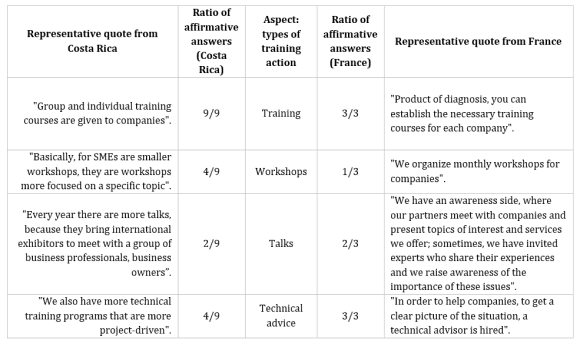
Table 3 goes deeper into detail and proposes a description of topics addressed in the French and Costa Rican training courses. In both countries, the institutions determine the issues to be dealt with for SMEs through demand analysis, that is, by studying the wishes and needs of companies. In Costa Rica, it we saw that some institutions also used expert criterion for the determining these issues. In the case of France, apart from the demand analysis, they also provided an analysis of trends.
Table 3. Setting topics for training SMEs
Table 4. SME response to this training
Concerning the SMEs’ perception of these training courses (Table 4), significant differences can be highlighted. In Costa Rica the institutions perceived high interest from SMEs in their services, while the French institutions expressed that in order to start activities with a company, they first need to make direct contact or introduce their services to SMEs.
This observation can also be related to the dissemination channels used by institutions in both countries to provide information about them and their services to the companies (Table 5). Institutions in both countries have websites and they also resort to sending promotional emails to their current and potential partners. In the case of Costa Rican institutions, great use is made of social networks to provide information to companies. In this respect, the French institutions did not indicate the use of these digital tools; on the other hand, they expressed that making direct contact with companies is what has given them the most results in establishing activities with SMEs.
Table 5. Media used to provide information to SMEs
Table 6. Promotion by institutions on digital marketing issues
Table 6 puts forward differences in the promotional approach of each type of institution. In Costa Rica, the promoter and public institutions promoted the theme of digital marketing in SMEs through their training services. It was discovered that the same promotions are not available from the university institutions that participated. In the case of the French institutions, this issue is promoted, but with no specific approach. Rather, digital marketing was seen as part of a larger development process included in other support initiatives.
Table 7. Digital marketing tools taught by institutions
With regard to the digital tools taught by the institutions (Table 7), a big difference was revealed between the two countries. In the case of Costa Rica, we ascertained that the digital tools on which they focus most for their training offers are the use of social networks (57 mentions), the design of a business website (40 mentions), and searcher positioning (26 mentions).In the French institutions, the list of digital tools taught to SMEs was defined according to the needs of each case, that is, they offer a more personalized service (15 mentions). Despite not having a predetermined list of topics to be addressed, some that have been used in the past were mentioned, such as the Industry 4.0 app, Google and Amazon Cloud tools, and Artificial Intelligence applications in some respects.
Concerning the capabilities taught to SMEs (Table 8), the situation occurs similarly to digital tools. The Costa Rican institutions already established capabilities that they want SMEs to achieve with digital marketing. The most mentioned were the training of a marketing strategy that integrates digital tools to become more competitive, followed by managing their distribution channels, having the possibility to expand their market, and strengthening relationships with suppliers, customers, and/or partners. In the case of French institutions, they again stated that the definition of skills to train SMEs with which they work was defined according to the needs of each case, with no pre-established list to be applied to all.
Table 8. Digital marketing capabilities taught by institutions
Table 9. Monitoring by the institutions to the knowledge transmitted to SMEs
Finally, regarding the monitoring that institutions realize in order to analyze the knowledge they transmit to SMEs, there is also a significant difference between the two countries. In Costa Rica, a lack of follow-up to SMEs could be noticed once training services had been completed. Only the promoters indicate that they usually do follow-up on this topic. In France, the situation is different. The monitoring of companies’ improvement is very intense throughout the training process provided by the institution. They offer accompaniment to SMEs throughout the development process which they undergo.
Discussions and Conclusion
The objective of this research work was to analyze the promotion given by institutions on the topic of digital marketing in both France and Costa Rica, based on a qualitative analysis of 12 interviews.
It was highlighted that promoting this issue exists in both countries, however, some particularities related to the context in which institutions operate arise. Significant differences were identified in the way institutions provide support to SMEs. These are mostly related to the domestic country of the institution, but also according to the type of institution.
The institutions interviewed in both countries use a website and email to provide information to and communicate with SMEs regarding their use of digital marketing. A difference appears in the use of social networks, where the institutions interviewed in Costa Rica claimed to carry out constant promotion on these different platforms, while French institutions still prefer to make direct contact with the company to report on their services.
Figure 1. How institutions promote digital marketing in small and medium international companies
In Costa Rica, only the university institutions do not cover digital marketing; but the other institutions interviewed, both in Costa Rica and in France, do offer a training services on this subject. And, in the case of France, this issue is seen as a part of the development process that institutions offer, rather than as an isolated subject. Regardless of the given approach for these institutions, is important to mention that the main interest for them to include this topic in their training services is to highlight the market opportunities that SMEs could have by using these types of tools, both in foreign and domestic markets. Some of these institutions even provide SMEs a clear path to follow to reach this specific goal. Thus, digital marketing promotion seems particularly correlated with export support offered by institutions. More specifically, promoter institutions made a great effort to take SMEs to an international level. These institutions affirmed that an important part of their mission was to support mainly SMEs in their international department; these institutions support companies in terms of training, analysis, or sending data to help them prepare to start exporting.
Regarding the content of these services, the Costa Rican institutions interviewed rely on a list of tools and defined capacities, specifically those that will be taught to SMEs. Some of the digital tools most mentioned in interviews were the use of social networks, website design, and positioning in search engines, while the capabilities they teach SMEs are the creation of a digital marketing strategy, increasing their competitiveness, managing distribution channels, expanding their market, and strengthening their relationships with customers, suppliers, and partners. On the other hand, the institutions interviewed in France do not have these aspects clearly defined. Instead of having a fixed digital marketing offer, they provide a more personalized service, on a case-by-case basis.
Finally, we discovered that the French institutions interviewed intensively follow the development of companies served. In Costa Rica, only the promoter institutions propose a follow up. For the others, their role ends once the training has been carried out.
This research work nevertheless has some limitations, related to the number of institutions that participated in the interviews. The clear difference in the number of institutions interviewed in each country made it difficult to analyze the data collected, as well as to make a geographical comparation. For this reason, the work proposed is explorative in essence and a deeper investigation should be carried out in order to confirm or refute the findings of this preliminary research work.
This research allowed us to build an exploratory picture of the realities that exist in both countries regarding the training given to companies, and also highlights more unknowns that would be interesting to cover in future work. For example, the number of support institutions available in each country could be a differentiating factor. France counts a notoriously smaller number of such institutions than does Costa Rica, and the organizations that predominate in the latter country and which are frequently used by SMEs are private ones. Another interesting unknown would be the preferences of SMEs when choosing an organization to acquire training, given that in Costa Rica there was a clear interest on the part of SMEs in the services offered by the institutions, as well as in France. Thus, a direct proposal design should be made for companies to attract them. A future study that can be derived from these results would be to identify the reasons why the training process in both countries is carried out in different ways.
Acknowledgements
We would like to thank the institutions from Costa Rica and France who agreed to participate in this research work. This work was supported in part by the French PIA project Lorraine Université d’Excellence, reference ANR-15-IDEX-04-LUE.
References
Aini, H. Q. & Hapsati, A. Y. 2019. Interests Influence of Digital Marketing Product Sales in Export by SMEs in Bandung. Global Business & Management Research, 11, (1): 217-225.
Alford, P. & Page, S.J. 2015. Marketing technology for adoption by small business. The Service Industries Journal, 35: 11-12, 655-669, DOI:10.1080/02642069.2015.1062884
Bianchi, C., & Mathews, S. 2016. Internet marketing and export market growth in Chile. Journal of Business Research, 69(2): 426-434.
Barbosa, Diana Marcela Escandón, and Andrea Hurtado Ayala. 2017. El Compromiso Exportador En Colombia: Un Análisis de Redes Neuronales. Revista de Métodos Cuantitativos Para La Economía y La Empresa, 24: 362-388.
Bhatia, Aparna, & Anu Thakur. 2018. Corporate Diversification and Firm Performance: An Empirical Investigation of Causality. International Journal of Organizational Analysis. https://doi.org/10.1108/IJOA-04-2017-1149.
Bołkunow, Wiktor. 2019. Internationalization of European Small and Medium-Sized Companies. In Eurasian Business Perspectives, Springer International Publishing.
Buckley, P.J., & M. Casson. 1976. The Future of the Multinational Enterprise. Macmillan. London.
Buckley, Peter J., & Mark Casson. 2019. The Internalization Theory of the Multinational Enterprise: Past, Present and Future. British Journal of Management 00: 1–14. https://doi.org/10.1111/1467-8551.12344.
Cangas Muxica, J. P., & Guzmán Pinto, M. 2010. Marketing Digital—Tendencias En Su Apoyo Al E-Commerce Y Sugerencias De Implementación. Economía U Chile, 121.
Clarke, G. 2008. Has the Internet increased exports for firms from low- and middle-income countries. Information Economics and Policy, 20 (1): 16-37.
Crick, Dave. 2007. SMEs’ Barriers Towards Internationalisation and Assistance Requirements in the UK: Differences Between Exporters and Firms Employing Multiple Modes of Market Entry. Journal of Small Business and Entrepreneurship 20 (3): 233–44. https://doi.org/10.1080/08276331.2007.10593397.
Cui, Annie Peng, Donald Gallion, & Michael F. Walsh. 2011. Internationalization Challenges for SMEs and Global Marketing Managers: A Case Study. International Journal of Business and Social Research 1 (1): 57–69.
Goodrick, D. 2014. Estudios de caso comparativos. Síntesis metodológicas: evaluación de impacto. UNICEF, 9: 1-18.
Hernández Sampieri, R., Fernández Collado, C., & Baptista Lucio, P. 2010. Metodología de la investigación (6th ed.) Mexico City: Mc Graw Hill
Justice, J.M. 2005. Análisis cualitativo de datos textuales con ATLAS. ti 5. Espanha: Universidade Autonoma de Barcelona. Lal, A. 2018. Digital Marketing: Redefining the Way Marketers Penetrate Markets. DAWN: Journal for Contemporary Research in Management, 5(1): 1-4.
Lee, Y. Y., & Falahat, M. 2019. The Impact of Digitalization and Resources on Gaining Competitive Advantage in International Markets: Mediating Role of Marketing, Innovation and Learning Capabilities. Technology Innovation Management Review, 9(11): 26–38.
Lemaire, Jean-Paul. 2013. Stratégies d’internationalisation: Nouveaux Engeux d’ouverture Des Organisations, Des Activités et Des Territoires. Edited by Dunod. 3rd Edition. Paris, France.
Lituchy, T. R., & Rail, A. 2000. Bed and breakfast, small inns, and the Internet. The Impact of technology on the globalization of small businesses. Journal of International Marketing, 8(2): 86-97.
Louw, Candice, & Cecile Nieuwenhuizen. 2019. Digitalization Strategies for SMEs: A Cost vs. Skill Approach for Website Development. African Journal of Science, Technology, Innovation and Development, July, 1–8. https://doi.org/10.1080/20421338.2019.1625591.
Maes, Elisabeth, Nico Dewaelheyns, Catherine Fuss, & Cynthia Van Hulle. 2019. The Impact of Exporting on Financial Debt Choices of SMEs. Journal of Business Research 102 (September): 56–73. https://doi.org/10.1016/j.jbusres.2019.05.008.
Mendez, J. G. C. 2003. Pymes innovadoras. Cambio de estrategias e instrumentos. Journal of Escuela de Administración de Negocios, (47).
Ministry of Economy, Industry and Trade .2019. Estudio Situacional de la PYME.
Mintzberg, Henry. 1979. The Structuring of Organizations. Englewood Cliffs, N.J: Pearson.
Morales, F. 2012. Conozca 3 tipos de investigación: Descriptiva, Exploratoria y Explicativa.
OECD. 2018. Fostering Greater SME Participation in a Globally Integrated Economy. In SME Ministerial Conference, 22.
Morgan, N. A., Katsikeas, C. S., & Vorhies, D. W. 2012. Export marketing strategy implementation, export marketing capabilities, and export venture performance. Journal of the Academy of Marketing Science, 40(2): 271–289. https://doi.org/10.1007/s11747-011-0275-0
Padachi, K. & Lukea Bhiwajee, S. 2016. Barriers to employee training in small and medium sized enterprises. European Journal of Training and Development, 40 (4): 232-247.
Parra-Penagos, C., & Rodríguez-Fonseca, F. 2016. La capacitación y su efecto en la calidad dentro de las organizaciones. Journal of Investigación, Desarrollo e Innovación, 6(2): 131-143.
Pérez-Fabara, M. A., & Charro, R. S. 2017. Motivación y esferas del consumidor digital. Journal Publicando, 4, 12 (2): 269-282.
Qurratu'Aini, H., & Hapsari, A. Y. 2019. Interests Influence of Digital Marketing Product Sales in Exports by SMEs in Bandung. Global Business and Management Research, 11(1): 217-225.
Reibstein, D.J., Day, G. & Wind, J. 2009. Guest editorial: is marketing academia losing its way?. Journal of Marketing, 7 (4):1-3.
Robles, B. 2011. La entrevista en profundidad: una técnica útil dentro del campo antropofísico. Cuicuilco, 18(52): 39-49.
Sojo-Castro, M., & Mora-Esquivel, R. 2017. Innovaciones organizativas y sus determinantes: Un estudio de casos comparativo. Tecnología en Marcha Magazine, 30(5): 3-12.
Taiminen, H. M., & Karjaluoto, H., 2015. The usage of digital marketing channels in SMEs. Journal of Small Business and Enterprise Development, 22(4): 633-651.
Taylor, S. J., & Bogdan, R. 1987. Introducción a los métodos cualitativos de investigación (Vol. 1). Barcelona: Paidós.
Verchaval, S. 2016. ¿Cuáles son las ventajas del marketing digital?
Keywords: coaching, digital marketing, internationalization, SMEs, support institutions, training

